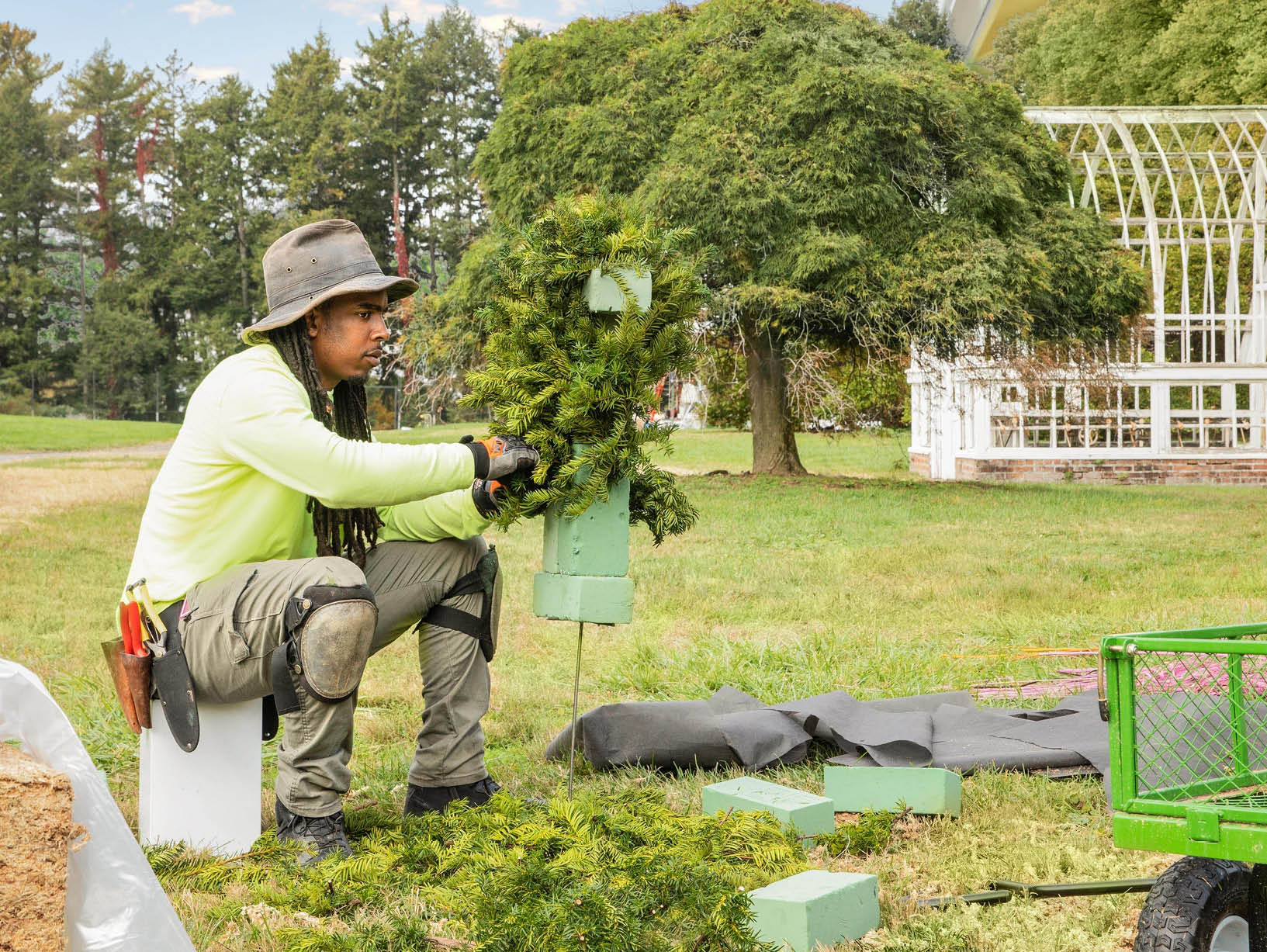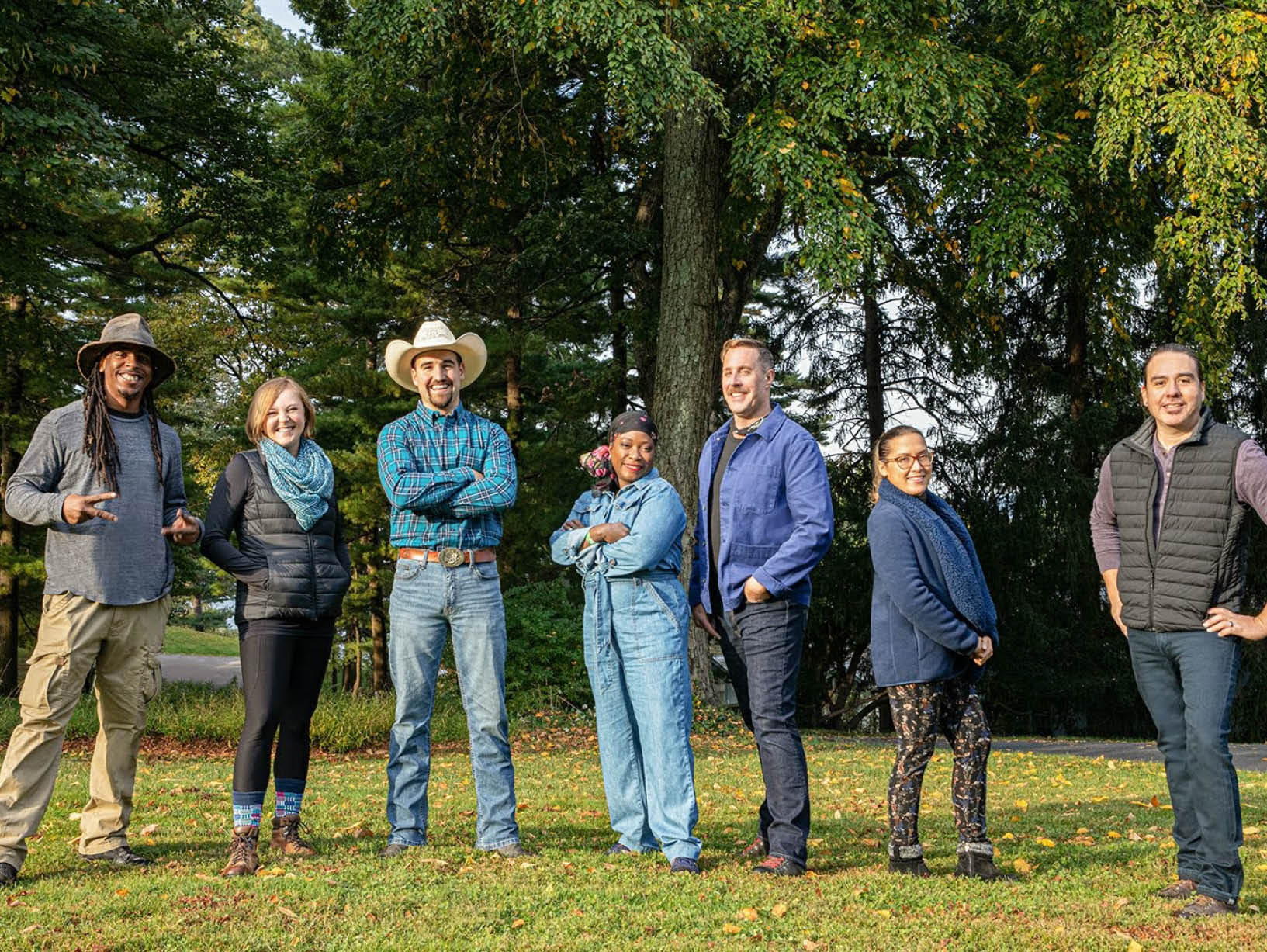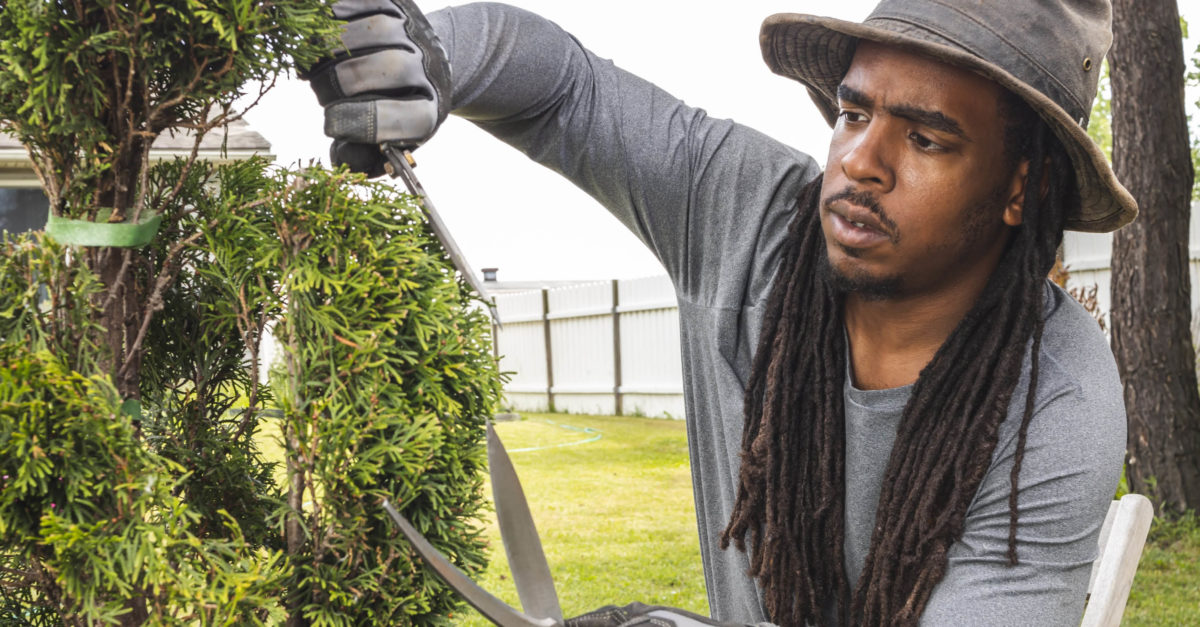The Tree Whisperer
Topiary artist Mike Gibson discusses his influences, his methods, and how beautiful greenery can impact lives.
How did you get interested in topiary design? Who influenced you?
I grew up in an artistic household. My father was an award-winning artist and taught me how to draw as a child, and that translated into the yard. I started learning how to cut bushes at age seven, which became a side hobby. By ten, I was working on neighbors’ yards, and by twelve I was doing work for people in the community.
In 2014, something just clicked. I started looking at trees differently and got more creative with topiary. I called it property art because I was beautifying properties. When I showed my dad what I’d created, he said it reminded him of Pearl Fryar. I didn’t know who that was, so I researched him. I was blown away that someone had already been doing this for such a long time.
Then I took out every topiary book I could from the library. In doing so, I learned about a British topiary artist named Jake Hobson, who was influenced by seventeenth-century Zen gardens and Japanese landscaping artistry called niwaki. Thanks to my dad, Pearl Fryar, and Jake Hobson, I found my mission: to create topiaries.

Tell us about how you beautified your hometown of Youngstown, Ohio:
I was living in Columbus and then moved back to Youngstown in 2014 to help beautify and revitalize it. One thing led to another, and soon I had a booming business. I decided I wanted to do something ambitious, and with our area code being 330, I set out to create 330 topiaries. It took me six years to finish that mission, and I’ve done over 400 total in Ohio. Until 2020, topiary was my side hustle; 2021 was the first year I did it full time.
Did you get to meet Pearl Fryar? How did it impact you?
I met Pearl for the first time in 2016. It was such a mind-blowing, life-changing experience. We walked around his famous garden in South Carolina, and I asked him a million questions. He gave me advice about using zip ties and wires and different kinds of binding techniques you’d find in bonsais, and I’ve applied all that knowledge to my work in Youngstown. I’ve gone back every year to meet Pearl and even proposed to my wife in front of his Love Garden.
When visiting Pearl in 2021, I learned that people were working to preserve his garden, and I wanted to be part of that mission. After seeing my work, they added me to the team to do the fine-tuning and restore many of the sculptures to a more pristine look. They hired me for twelve months as a topiary artist and an instructor along with Pearl. I moved to South Carolina and am now restoring the gardens, teaching an apprentice, conducting tours, and soliciting volunteers.

When you work on a topiary project, can you immediately envision what you’ll do?
Good question. When I first started, I’d sketch everything out, a habit I learned from my father and fine-art school. I also cut and sculpted hair with my mom, which helped me to see bushes a little differently.
Nowadays, I’m more like a tree whisperer. The trees tell me what they want to be, and I listen. I can see the lines, curves, and images very fast. I’m also inspired by the client and the surroundings—I want the sculptures to be intentional and tell stories. I also like to do what I call illusion art, where you see different things based on your perspective. So as you walk around the sculpture, it’ll constantly change.
What are your go-to tools for such work?
I wear a utility belt with six different shears, a pair of snips, which allows me to get closer to the trunk of the tree, and two pairs of hand shears, which are like giant scissors with long blades. I’m ambidextrous, so I clip with both hands. Ninety percent of my sculptures have been created by hand, which sets me apart from everyone else.
Are you a big fan of Edward Scissorhands?
Of course! In fact, my nickname is Gibby Scissorhands because people saw my Instagram videos and thought I was cutting really fast like the character. It got shortened even more to GibbySiz by a casting director when I did the Discovery+ show Clipped.

How was your experience on Clipped?
It was amazing, and I learned a lot. I’ve been interviewed a lot about topiary, but being in front of that many cameras for twelve hours is challenging. And Martha Stewart is intimidating. I was starstruck by her but even more so by Chris Lambton because I had binge-watched his show, Yard Crashers, before doing the show. It was surreal.
This seems like a creative yet exacting line of work. Is it difficult to juggle the two?
I have three fundamentals for topiary: you must be confident in your vision, believe in yourself, and be patient with your technique. I compare topiary with life—you’ve got to be able to prune off some of your bad habits to be more successful. For topiary to come alive, you must prune some of the dead branches off. If you cut off something unintentionally, that’s OK; it’ll either grow back or it’s an opportunity to do something new. And if you’re not patient, topiary isn’t for you. Some designs take years to come to life. However, after working so long on my craft, I like instant gratification. I want to immediately transform a landscape to make people take notice when they drive by.
How can good topiary design benefit a home and a community?
In my opinion, it’s the best thing you can do to improve your curb appeal. It can raise your property value because the first thing a prospective buyer sees is the outside, and it immediately adds an artistic look to your property. It’s no longer just a landscape—it’s a creative, elevated landscape.
It might be even more important to a community. Studies show that having more topiary in an area reduces crime. In general, the more beautiful a neighborhood becomes, the more appreciative the residents will be. There’s a domino effect: neighbors will want to keep up with the Joneses. You don’t want to be that neighbor who doesn’t cut their grass or doesn’t trim their bushes.

Which project are you proudest of?
That’s tough. Each sculpture is unique. But I’m proud of the sculptures I’ve done at Fellows Riverside Gardens in Youngstown’s Mill Creek Park, where I was a topiary artist-in-residence. I created ten different topiaries for the park’s sixtieth anniversary, and they’re still there today. That’s my prized possession; instead of sending people to a house to see my work, I’ll send them there. They named me Artist of the Year in 2018, which is special because I’ve visited the park my whole life.
Does your yard look pristine all the time?
It does. [Laughs] Honestly, when I lived in Youngstown, it kind of got away from me because I was taking care of everybody else’s. However, I’ve kept up with my yard here in South Carolina and even did my neighbor’s. I’m trying to make a mark wherever I go.
For more info, visit gibsontopiary.com






















